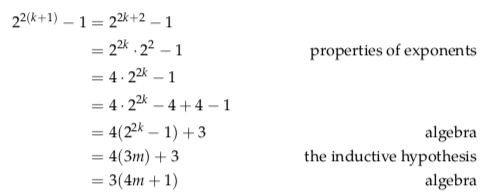2.5.2: Examples
- Page ID
- 10076
\( \newcommand{\vecs}[1]{\overset { \scriptstyle \rightharpoonup} {\mathbf{#1}} } \)
\( \newcommand{\vecd}[1]{\overset{-\!-\!\rightharpoonup}{\vphantom{a}\smash {#1}}} \)
\( \newcommand{\id}{\mathrm{id}}\) \( \newcommand{\Span}{\mathrm{span}}\)
( \newcommand{\kernel}{\mathrm{null}\,}\) \( \newcommand{\range}{\mathrm{range}\,}\)
\( \newcommand{\RealPart}{\mathrm{Re}}\) \( \newcommand{\ImaginaryPart}{\mathrm{Im}}\)
\( \newcommand{\Argument}{\mathrm{Arg}}\) \( \newcommand{\norm}[1]{\| #1 \|}\)
\( \newcommand{\inner}[2]{\langle #1, #2 \rangle}\)
\( \newcommand{\Span}{\mathrm{span}}\)
\( \newcommand{\id}{\mathrm{id}}\)
\( \newcommand{\Span}{\mathrm{span}}\)
\( \newcommand{\kernel}{\mathrm{null}\,}\)
\( \newcommand{\range}{\mathrm{range}\,}\)
\( \newcommand{\RealPart}{\mathrm{Re}}\)
\( \newcommand{\ImaginaryPart}{\mathrm{Im}}\)
\( \newcommand{\Argument}{\mathrm{Arg}}\)
\( \newcommand{\norm}[1]{\| #1 \|}\)
\( \newcommand{\inner}[2]{\langle #1, #2 \rangle}\)
\( \newcommand{\Span}{\mathrm{span}}\) \( \newcommand{\AA}{\unicode[.8,0]{x212B}}\)
\( \newcommand{\vectorA}[1]{\vec{#1}} % arrow\)
\( \newcommand{\vectorAt}[1]{\vec{\text{#1}}} % arrow\)
\( \newcommand{\vectorB}[1]{\overset { \scriptstyle \rightharpoonup} {\mathbf{#1}} } \)
\( \newcommand{\vectorC}[1]{\textbf{#1}} \)
\( \newcommand{\vectorD}[1]{\overrightarrow{#1}} \)
\( \newcommand{\vectorDt}[1]{\overrightarrow{\text{#1}}} \)
\( \newcommand{\vectE}[1]{\overset{-\!-\!\rightharpoonup}{\vphantom{a}\smash{\mathbf {#1}}}} \)
\( \newcommand{\vecs}[1]{\overset { \scriptstyle \rightharpoonup} {\mathbf{#1}} } \)
\( \newcommand{\vecd}[1]{\overset{-\!-\!\rightharpoonup}{\vphantom{a}\smash {#1}}} \)
\(\newcommand{\avec}{\mathbf a}\) \(\newcommand{\bvec}{\mathbf b}\) \(\newcommand{\cvec}{\mathbf c}\) \(\newcommand{\dvec}{\mathbf d}\) \(\newcommand{\dtil}{\widetilde{\mathbf d}}\) \(\newcommand{\evec}{\mathbf e}\) \(\newcommand{\fvec}{\mathbf f}\) \(\newcommand{\nvec}{\mathbf n}\) \(\newcommand{\pvec}{\mathbf p}\) \(\newcommand{\qvec}{\mathbf q}\) \(\newcommand{\svec}{\mathbf s}\) \(\newcommand{\tvec}{\mathbf t}\) \(\newcommand{\uvec}{\mathbf u}\) \(\newcommand{\vvec}{\mathbf v}\) \(\newcommand{\wvec}{\mathbf w}\) \(\newcommand{\xvec}{\mathbf x}\) \(\newcommand{\yvec}{\mathbf y}\) \(\newcommand{\zvec}{\mathbf z}\) \(\newcommand{\rvec}{\mathbf r}\) \(\newcommand{\mvec}{\mathbf m}\) \(\newcommand{\zerovec}{\mathbf 0}\) \(\newcommand{\onevec}{\mathbf 1}\) \(\newcommand{\real}{\mathbb R}\) \(\newcommand{\twovec}[2]{\left[\begin{array}{r}#1 \\ #2 \end{array}\right]}\) \(\newcommand{\ctwovec}[2]{\left[\begin{array}{c}#1 \\ #2 \end{array}\right]}\) \(\newcommand{\threevec}[3]{\left[\begin{array}{r}#1 \\ #2 \\ #3 \end{array}\right]}\) \(\newcommand{\cthreevec}[3]{\left[\begin{array}{c}#1 \\ #2 \\ #3 \end{array}\right]}\) \(\newcommand{\fourvec}[4]{\left[\begin{array}{r}#1 \\ #2 \\ #3 \\ #4 \end{array}\right]}\) \(\newcommand{\cfourvec}[4]{\left[\begin{array}{c}#1 \\ #2 \\ #3 \\ #4 \end{array}\right]}\) \(\newcommand{\fivevec}[5]{\left[\begin{array}{r}#1 \\ #2 \\ #3 \\ #4 \\ #5 \\ \end{array}\right]}\) \(\newcommand{\cfivevec}[5]{\left[\begin{array}{c}#1 \\ #2 \\ #3 \\ #4 \\ #5 \\ \end{array}\right]}\) \(\newcommand{\mattwo}[4]{\left[\begin{array}{rr}#1 \amp #2 \\ #3 \amp #4 \\ \end{array}\right]}\) \(\newcommand{\laspan}[1]{\text{Span}\{#1\}}\) \(\newcommand{\bcal}{\cal B}\) \(\newcommand{\ccal}{\cal C}\) \(\newcommand{\scal}{\cal S}\) \(\newcommand{\wcal}{\cal W}\) \(\newcommand{\ecal}{\cal E}\) \(\newcommand{\coords}[2]{\left\{#1\right\}_{#2}}\) \(\newcommand{\gray}[1]{\color{gray}{#1}}\) \(\newcommand{\lgray}[1]{\color{lightgray}{#1}}\) \(\newcommand{\rank}{\operatorname{rank}}\) \(\newcommand{\row}{\text{Row}}\) \(\newcommand{\col}{\text{Col}}\) \(\renewcommand{\row}{\text{Row}}\) \(\newcommand{\nul}{\text{Nul}}\) \(\newcommand{\var}{\text{Var}}\) \(\newcommand{\corr}{\text{corr}}\) \(\newcommand{\len}[1]{\left|#1\right|}\) \(\newcommand{\bbar}{\overline{\bvec}}\) \(\newcommand{\bhat}{\widehat{\bvec}}\) \(\newcommand{\bperp}{\bvec^\perp}\) \(\newcommand{\xhat}{\widehat{\xvec}}\) \(\newcommand{\vhat}{\widehat{\vvec}}\) \(\newcommand{\uhat}{\widehat{\uvec}}\) \(\newcommand{\what}{\widehat{\wvec}}\) \(\newcommand{\Sighat}{\widehat{\Sigma}}\) \(\newcommand{\lt}{<}\) \(\newcommand{\gt}{>}\) \(\newcommand{\amp}{&}\) \(\definecolor{fillinmathshade}{gray}{0.9}\)Let’s look at a few examples.
Theorem 3.5.
The number \(2^{2 n}\) − 1 is divisible by 3 for all natural numbers n.
Proof. Here, P(n) is the statement that \(2^{2 n}\) − 1 is divisible by 3.
Base case: When \(n=0,2^{2 n}-1=2^{0}-1=1-1=0\) and 0 is divisible by 3 (since 0 = 3 · 0.) Therefore the statement holds when n = 0.
Inductive case: We want to show that if the statement is true for n = k (where k is an arbitrary natural number), then it is true for n = k + 1 also. That is, we must prove the implication \(P(k) \rightarrow P(k+1) .\) So we assume \(P(k),\) that is, we assume that \(2^{2 k}\) is divisible by \(3 .\) This means that \(2^{2 k}-1=3 m\) for some integer \(m .\) We want to prove \(P(k+1),\) that is, that \(2^{2(k+1)}-1\) is also divisible by \(3 :\)

and from the last line we see that \(2^{2 k+1}\) is in fact divisible by 3. (The third step-subtractin and adding 4—was done to enable us to use our inductive hypothesis.) Altogether, we have proved that P(0) holds and that, for all k, P(k) → P(k + 1) is true. Therefore, by the principle of induction, \(P(n)\) is true for all \(n\) in \(\mathbb{N},\) i.e. \(2^{2 n}-1\) is divisible by 3 for all n in N.
The principle of mathematical induction gives a method for proving P(n) for all n in the set N. It should be clear that if M is any natural number, a similar method can be used to show that P(n) is true for all natural numbers n that satisfy n ≥ M. Just start the induction with a base case of n = M instead of with a base case of n = 0. I leave the proof of this extension of the principle of induction as an exercise. We can use the extended principle of induction to prove a result that was first mentioned in Section 2.1.
Theorem 3.6.
Suppose that a compound proposition contains exactly n propositional variables, where \(n \geq 1 .\) Then there are exactly \(2^{n}\) different ways of assigning truth walues to the n variables.
Proof. Let P(n) be the statement “There are exactly \(2^{n}\) different ways of assigning truth values to n propositional variables.” We will use induction to prove the P(n) is true for all n ≥ 1.
Base case: First, we prove the statement P(1). If there is exactly one variable, then there are exactly two ways of assigning a truth value to that variable. Namely, the variable can be either true or false. Since \(2=2^{1}, P(1)\) is true.
Inductive case: Suppose that P(k) is already known to be true. We want to prove that, under this assumption, \(P(k+1)\) is also true. Suppose that \(p_{1}, p_{2}, \ldots, p_{k+1}\) are \(k+1\) propositional variables. Since we are assuming that P(k) is true, we know that there are \(2^{k}\) ways of assigning truth values to \(p_{1}, p_{2}, \dots, p_{k} .\) But each assignment of truth values to \(p_{1}, p_{2}, \ldots, p_{k}\) can be extended to the complete list \(p_{1}, p_{2}, \ldots, p_{k}, p_{k+1}\) in two ways. Namely, \(p_{k+1}\) can be assigned the value true or the value false. It follows that there are 2\(\cdot 2^{k}\) ways of assigning truth values to \(p_{1}, p_{2}, \ldots, p_{k+1} .\) since \(2 \cdot 2^{k}=2^{k+1},\) thishes the proof.

